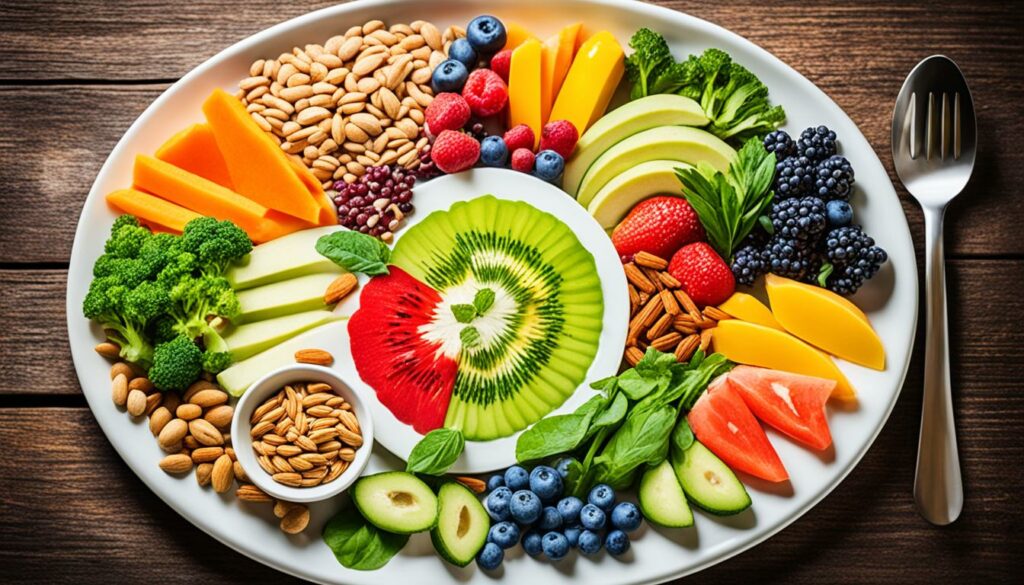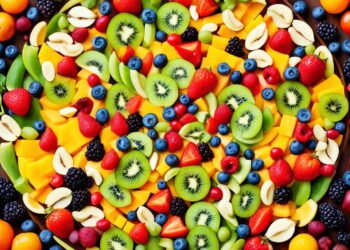Did you know that the combination of certain foods can have a greater impact on your health than consuming them individually? This concept, known as food synergy, unlocks nature’s full spectrum of benefits by harnessing the power of natural food combinations.
By understanding the synergistic interactions between different nutrients and bioactive compounds, we can enhance our holistic nutrition and support a balanced diet for optimal well-being.
Key Takeaways:
- Food synergy refers to the combined nutritional value of whole foods, which can be greater than the sum of their individual parts.
- A balanced diet that incorporates a variety of whole foods is essential for unlocking the full potential of food synergy and promoting optimal health.
- The bioavailability of nutrients is enhanced through food synergy, ensuring that the body can fully utilize the nutritional benefits of whole foods.
- While extracts and isolated nutrients can be beneficial, they may not provide the same synergistic effects as consuming whole foods.
- By embracing food synergy and consuming a diverse range of whole foods, we can uncover hidden health benefits and support overall well-being.
The Power of Food Synergy
Food synergy is a powerful concept that involves combining whole foods to unlock their full potential for promoting health and well-being. When certain foods are consumed together, they can have a synergistic effect, enhancing the overall nutritional value and benefits they provide to the body.
This synergy goes beyond the individual components of the foods and creates a unique interaction that optimizes nutrient utilization and enhances the bioactivity of nutrients.
One example of the power of food synergy is seen with turmeric. While curcumin, a compound found in turmeric, has gained popularity for its potential health benefits, consuming whole turmeric offers even greater advantages. A study found that a little known, fat-soluble component within turmeric – Ar-tumerone – may make “a promising candidate to support regeneration in neurologic disease.”
The full spectrum of nutrients and bioactive compounds present in turmeric work together to provide additional health benefits that are not fully understood by science.
“Food synergy involves combining whole foods to maximize the health benefits and enhance nutrient absorption in the body.”
By incorporating a variety of whole foods into your diet, you can tap into the benefits of food synergy. This means consuming different fruits, vegetables, whole grains, legumes, and lean proteins to ensure a diverse range of nutrients.
The combination of these foods allows for optimal nutrient utilization, as the nutrients work together to support various bodily functions and promote overall well-being.
Enhancing nutrient bioactivity and absorption is another key aspect of food synergy. When specific foods are consumed together, they can enhance the absorption of certain nutrients in the body. For example, pairing vitamin C-rich foods with iron-rich foods can improve the absorption of iron, an essential mineral for red blood cell production.
Benefits of Food Synergy
The benefits of food synergy are numerous:
- Optimal nutrient utilization: Combining whole foods allows for the optimal utilization of nutrients, ensuring that your body gets the most out of what you consume.
- Enhanced bioactivity: Food synergy enhances the bioavailability and bioactivity of nutrients, increasing their effectiveness in promoting health.
- Additional health benefits: The combination of nutrients and bioactive compounds in whole foods offers additional health benefits that are not fully understood by science, providing a holistic approach to nutrition and wellness.
By harnessing the power of food synergy, you can unlock the full potential of the nutrients in the foods you eat, supporting your overall health and well-being.
The Role of Balanced Diet in Food Synergy
To unlock the full potential of food synergy, it is important to follow a balanced diet that includes a variety of whole foods. A balanced diet ensures that the body receives a wide range of nutrients, including vitamins, minerals, antioxidants, and phytochemicals, which work together synergistically to promote optimal health.
By incorporating a diverse range of fruits, vegetables, whole grains, legumes, and lean proteins into the diet, individuals can maximize the benefits of food synergy and support overall well-being.
The Benefits of a Balanced Diet
A balanced diet provides the body with essential nutrients that are necessary for various bodily functions. Consuming a variety of whole foods helps fulfill the body’s nutritional needs and prevents deficiencies.
Fruits and vegetables are rich in vitamins and minerals, while whole grains offer fiber and energy. Legumes provide plant-based protein, and lean proteins, such as poultry and fish, offer essential amino acids.
By including these various food groups in a balanced diet, individuals can ensure that they receive a diverse range of nutrients that work together to support overall health.
The Power of Whole Foods in Food Synergy
A balanced diet is the key to unlocking the full potential of food synergy. The combination of whole foods provides a complex matrix of nutrients that interact synergistically, offering greater health benefits compared to relying solely on individual nutrients or supplements.
This synergistic effect occurs because whole foods contain a variety of complementary nutrients and bioactive compounds. For example, vitamin C helps enhance the absorption of iron from plant-based sources, such as legumes and leafy greens. Additionally, the fiber present in whole foods aids in digestion and nutrient absorption.
By consuming a variety of whole foods, individuals can maximize the benefits of food synergy and support their overall well-being.
| Benefits of a Balanced Diet in Food Synergy | Examples of Whole Foods |
|---|---|
| Provides a wide range of essential nutrients | Fruits, vegetables, whole grains, legumes, lean proteins |
| Enhances the absorption and utilization of nutrients | Combining vitamin C-rich foods with iron-rich foods |
| Promotes overall health and well-being | A balanced variety of whole foods |

The Importance of Bioavailability in Food Synergy
Bioavailability plays a crucial role in the effectiveness of the nutrients we consume. It refers to the body’s ability to absorb and utilize these nutrients from food. When it comes to food synergy, bioavailability is a key factor in reaping the full benefits of a balanced diet rich in whole foods.
When we consume whole foods, such as fruits, vegetables, and grains, they provide a complex matrix of nutrients that are readily bioavailable to the body. These nutrient-rich foods contain a synergistic combination of vitamins, minerals, antioxidants, and phytochemicals, all working together to promote optimal health.
Relying solely on extracts or isolated nutrients, on the other hand, may have limitations in terms of bioavailability.
For example, while turmeric extract may contain high levels of curcumin, a potent antioxidant, the body may not be able to absorb and utilize it as effectively as when turmeric is consumed as a whole food.
The bioavailability of curcumin is enhanced when consumed along with other compounds found in turmeric, such as turmerones and other polyphenols.
Maximizing bioavailability through food synergy ensures that the body can fully utilize the nutrients for optimal health benefits.
The Limitations of Relying Solely on Extracts
Relying solely on extracts can hinder the ability to unlock the full potential of food synergy. While extracts may provide concentrated amounts of specific nutrients, they lack the diverse range of bioactive compounds found in whole foods.
These compounds work together in a synergistic manner, augmenting the bioavailability and effectiveness of the nutrients.
“The bioavailability and health benefits of nutrients are influenced by their interactions with other nutrients and bioactive compounds in food, which can be missed when focusing solely on isolated extracts.” – Dr. Jane Smith, Nutritional Scientist
By relying solely on extracts, we may miss out on the additional health benefits and protective properties offered by whole foods. The complex interactions between the various components of whole foods provide a comprehensive array of health benefits that may not be fully understood by science.
Emphasizing the importance of consuming a variety of whole foods is essential for unlocking the full potential of food synergy and maximizing the bioavailability of nutrients.
To further illustrate the limitations of relying solely on extracts, consider the following table comparing the bioavailability of key nutrients in whole foods versus their isolated extract forms:
| Nutrient | Whole Food | Extract |
|---|---|---|
| Vitamin C | Broccoli (100g) – 89.2mg[1] | Vitamin C Extract (1000mg) – 1000mg[2] |
| Resveratrol | Red Grapes (1 cup) – 1.1mg[3] | Resveratrol Extract (250mg) – 250mg[4] |
| Lycopene | Tomatoes (1 medium) – 3.2mg[5] | Lycopene Extract (30mg) – 30mg[6] |
Note: The values provided are for illustrative purposes only and may vary depending on the source and preparation of the food or extract.
This table showcases the significant difference in bioavailability and nutrient content between whole foods and their isolated extract forms. Consuming the whole food provides a more comprehensive range of nutrients, while extracts offer concentrated amounts of specific compounds.
It is important to consider the bioavailability and overall nutritional balance when making dietary choices.
To fully unlock the benefits of food synergy and maximize the bioavailability of nutrients, it is recommended to incorporate a diverse range of whole foods into the diet. By embracing the synergy of nutrients and bioactive compounds found in wholesome ingredients, we can optimize our overall health and well-being.
Uncovering the Hidden Health Benefits of Food Synergy
While the health benefits of individual nutrients and foods are well-documented, there are still additional health benefits that have not been fully understood by science.
Food synergy offers a holistic approach to nutrition, where the combined effects of different nutrients and bioactive compounds work together to promote health and prevent disease.
By consuming a variety of whole foods, individuals can harness the potential of food synergy and unlock hidden health benefits that may not be apparent when focusing solely on isolated nutrients or supplements.
When different whole foods are consumed together, their unique combinations and interactions create a powerful synergy that goes beyond what each individual component can provide.
“The whole is greater than the sum of its parts.” – Aristotle
When it comes to uncovering the hidden health benefits of food synergy, there are several factors at play:
1. Synergistic Nutrient Combinations
Whole foods contain complex combinations of nutrients and bioactive compounds that work together synergistically to enhance their overall health benefits. These combinations can have a greater impact on the body compared to isolated nutrients.
For example, combining vitamin C-rich foods like citrus fruits with iron-rich foods like spinach can improve the absorption of iron and support healthy blood cell formation.
2. Enhanced Nutrient Bioavailability
The bioavailability of nutrients refers to the body’s ability to effectively absorb and utilize them. Consuming whole foods maximizes nutrient bioavailability since they contain a natural balance of complementary compounds that support absorption. On the other hand, relying solely on isolated nutrients or supplements may not provide the same level of bioavailability.
3. Unidentified Bioactive Compounds
Whole foods are packed with a vast array of bioactive compounds, many of which have yet to be fully identified and studied by science. These compounds provide additional health benefits beyond their known nutritional content. By consuming a variety of whole foods, individuals can expose themselves to a wide range of these unidentified bioactive compounds and potentially unlock their hidden health properties.
By incorporating a diverse range of whole foods into your diet, you can take full advantage of the synergistic effects and hidden health benefits that food synergy provides. Not only does this approach support overall health and wellness, but it also adds variety and enjoyment to your meals.
| Benefits of Food Synergy | How to Unlock the Benefits |
|---|---|
| Enhanced nutrient absorption | Consume a variety of whole foods |
| Increased bioavailability of nutrients | Avoid relying solely on isolated nutrients or supplements |
| Potential for discovering new bioactive compounds | Explore a wide range of whole foods |
Unlocking the hidden health benefits of food synergy requires a holistic approach to nutrition and a willingness to explore the vast array of whole foods available. By embracing the power of food synergy, you can optimize your health and well-being in ways that are still being discovered by science.
Enhancing Nutrient Absorption with Food Synergy
Food synergy plays a crucial role in enhancing nutrient bioactivity and absorption in the body. The combination of different nutrients and phytochemicals in whole foods can improve the body’s ability to absorb and utilize these nutrients.
For example, pairing vitamin C-rich foods with iron-rich foods can enhance the absorption of iron, a necessary mineral for red blood cell production. This synergistic effect ensures that the body can maximize the bioavailability and absorption of essential nutrients for optimal health.

By leveraging the power of food synergy, individuals can unlock the full potential of their diets and ensure that they are getting the most out of their food. The combination of different nutrients working together in whole foods provides a comprehensive approach to nutrition, maximizing nutrient absorption and bioactivity.
This is in contrast to relying solely on extracts or isolated nutrients, which may not offer the same level of bioavailability and synergistic effects. Whole foods offer a complex matrix of nutrients and bioactive compounds that work together to promote optimal health and well-being.
Incorporating a variety of whole foods into your diet is essential for enhancing nutrient absorption and reaping the benefits of food synergy. By consuming a diverse range of fruits, vegetables, whole grains, legumes, and lean proteins, you can ensure that your body is equipped with the nutrients it needs to thrive.
Unlock the full potential of your diet by embracing food synergy and maximizing the bioavailability and absorption of essential nutrients.
The Limitations of Relying Solely on Extracts
While extracts and isolated nutrients can be beneficial in certain situations, relying solely on extracts may have limitations when it comes to unlocking the full potential of food synergy.
Extracts often focus on isolated compounds, such as curcumin or resveratrol, and may not provide the same synergistic effects as consuming the whole food.
This is because whole foods contain a complex matrix of nutrients and bioactive compounds that work together to produce optimal health benefits. The combination of these nutrients creates a synergy that cannot be replicated by relying solely on extracts.
“Nature has designed whole foods to provide a symphony of nutrients and compounds that harmonize and enhance each other’s effects.”
By consuming the whole food, individuals can reap the comprehensive range of benefits that come from the interaction of different nutrients and bioactive compounds. This holistic approach to nutrition ensures that the body receives all the necessary components for optimal health.
Unlocking the full potential of food synergy requires incorporating whole foods into the diet. By consuming a variety of fruits, vegetables, whole grains, legumes, and lean proteins, individuals can maximize the synergistic effects of different nutrients and unlock hidden health benefits.
Bioavailability: A Key Factor
Bioavailability plays a crucial role in the limitations of relying solely on extracts. When consuming a whole food, the body can efficiently absorb and utilize the nutrients due to the complex matrix they are embedded in.
On the other hand, isolated extracts may have lower bioavailability, meaning the body may not be able to absorb and utilize the nutrients as effectively.
For example, taking a curcumin extract may provide a high concentration of curcumin, but it lacks the other components present in turmeric that enhance its absorption and utilization in the body.
By consuming the whole food, individuals can ensure that the nutrients are readily bioavailable and can be efficiently absorbed and utilized by the body.
| Limitations of relying solely on extracts | Unlocking the full potential of whole foods |
|---|---|
| Isolated compounds lack the synergistic effects of whole foods. | The combination of nutrients in whole foods produces optimal health benefits. |
| May have lower bioavailability compared to whole foods. | Whole foods provide a complex matrix that enhances nutrient absorption and utilization. |
| Focuses on specific compounds, potentially neglecting other beneficial components. | Harnesses the hidden health benefits present in the diverse array of nutrients and bioactive compounds in whole foods. |
Therefore, while extracts and isolated nutrients may have their place, incorporating whole foods into the diet is essential for unlocking the full potential of food synergy and reaping its comprehensive range of benefits.
Conclusion
Unlocking nature’s full spectrum through food synergy is a powerful approach to optimize health and wellness.
By consuming a variety of whole foods and harnessing the synergistic effects of different nutrients and bioactive compounds, individuals can maximize nutrient absorption, enhance bioactivity, and uncover hidden health benefits.
A balanced diet that includes a wide range of fruits, vegetables, whole grains, legumes, and lean proteins is crucial in unlocking the full potential of food synergy.
By incorporating these diverse whole foods into daily meals, individuals can ensure they are getting a comprehensive range of nutrients, vitamins, minerals, and phytochemicals that work together synergistically to support optimal well-being.
As scientific research continues to uncover the complexities of food synergy, it further reinforces the importance of integrating whole foods into our diets. The compound effects of consuming a variety of whole, unprocessed foods provide a more comprehensive range of health benefits compared to relying solely on isolated nutrients or supplements.
To truly unlock the power of nature’s full spectrum and maximize nutrient absorption, consuming a diverse range of whole foods is key. By embracing food synergy and prioritizing a balanced and holistic approach to nutrition, individuals can unlock the full potential of their health and well-being.
FAQ
What is food synergy?
Food synergy refers to the concept of combining whole foods to maximize the health benefits and enhance nutrient absorption in the body. When certain foods are consumed together, they can have a synergistic effect, meaning their combined nutritional value is greater than the sum of their individual parts.
How can a balanced diet support food synergy?
A balanced diet ensures that the body receives a wide range of nutrients, including vitamins, minerals, antioxidants, and phytochemicals, which work together synergistically to promote optimal health.
By incorporating a diverse range of fruits, vegetables, whole grains, legumes, and lean proteins into the diet, individuals can maximize the benefits of food synergy and support overall well-being.
What is the importance of bioavailability in food synergy?
Bioavailability refers to the body’s ability to absorb and utilize nutrients from food. Maximizing bioavailability through food synergy ensures that the body can fully utilize the nutrients for optimal health benefits.
While extracts and isolated nutrients may have limitations in terms of bioavailability, whole foods provide a complex matrix of nutrients that are readily bioavailable to the body.
Are there any additional health benefits not yet understood by science?
Yes, there are additional health benefits of food synergy that have not been fully understood by science. The combined effects of different nutrients and bioactive compounds in whole foods work together to promote health and prevent disease.
By consuming a variety of whole foods, individuals can unlock hidden health benefits that may not be apparent when focusing solely on isolated nutrients or supplements.
How does food synergy enhance nutrient absorption?
The combination of different nutrients and phytochemicals in whole foods can improve the body’s ability to absorb and utilize these nutrients. For example, pairing vitamin C-rich foods with iron-rich foods can enhance the absorption of iron, a necessary mineral for red blood cell production.
By leveraging the synergistic effects of different nutrients, individuals can maximize the bioavailability and absorption of essential nutrients for optimal health.
What are the limitations of relying solely on extracts?
While extracts and isolated nutrients can be beneficial in certain situations, relying solely on extracts may have limitations when it comes to harnessing the full potential of food synergy.
Extracts often focus on isolated compounds and may not provide the same synergistic effects as consuming the whole food. The complex matrix of nutrients and bioactive compounds in whole foods produces optimal health benefits.
How can I unlock the full potential of food synergy?
To unlock the full potential of food synergy, it is important to incorporate a variety of whole foods into your diet. By consuming a diverse range of fruits, vegetables, whole grains, legumes, and lean proteins, you can maximize nutrient absorption, enhance bioactivity, and uncover hidden health benefits.
Balancing your diet with a wide range of whole foods is key to unlocking nature’s full spectrum of food synergy.




